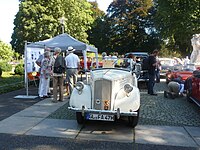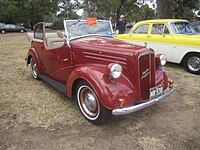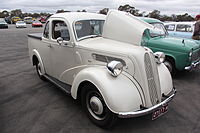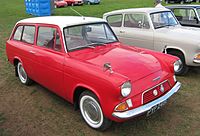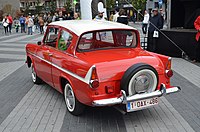Ford Anglia
| Ford Anglia | |
|---|---|
Front-engine, rear-wheel-drive | |
| Chronology | |
| Predecessor | Ford 7Y |
| Successor | Ford Escort |
The Ford Anglia is a small family car that was designed and manufactured by Ford UK. It is related to the Ford Prefect and the later Ford Popular. The Anglia name was applied to various models between 1939 and 1967. In total, 1,594,486 Anglias were produced. It was replaced by the Ford Escort.
Unique variants of the Anglia were produced by Ford Australia and by the Italian subsidiary of Ford.
Anglia E04A (1939–1948)
| Ford Anglia E04A | |
|---|---|
| Dimensions | |
| Wheelbase | 90 in (2,286 mm)[3] |
| Length | 152 in (3,861 mm)[3] |
| Width | 57 in (1,448 mm)[3] |
| Height | 63 in (1,600 mm)[3] |
The first Ford Anglia model, the E04A, was released on 31 October 1939 as the smallest model in the UK Ford range.
The two-door Anglia is similar to the longer, four-door, E93A Ford Prefect. A bulge at the back enabled a spare wheel to be removed from its vertical outside stowage on the back of the car and stowed flat on the boot floor, which usefully increased luggage space. Some back-seat leg room was sacrificed to the luggage space, being reduced from 43+3⁄4 inches (1,110 mm) in the Ford 7Y to 38+1⁄2 inches (980 mm) in the Anglia.[3] The Anglia replaced the 7Y saloon, but the van version of the earlier model continued to be built until 1946, after which some very minor changes sufficed to rename the van the "E04C".[4]
The domestic market engine was the 933 cc (56.9 cu in)
The car retained a vacuum-powered wiper with its tendency to slow down or stop above about 40 mph (64 km/h), the point at which the suction effect from the induction manifold disappeared; however, the Anglia's wipers were supported by a vacuum reservoir, which partially addressed the propensity to stop entirely when the car was accelerated.[3]
A contemporary road test commended the Anglia's ability to pull away from 5 or 6 mph (8.0 or 9.7 km/h) in top gear.
Production, hindered by the diversion of Ford's factory to military production during the Second World War, ceased in 1948 after 55,807 had been built. Initial sales in Britain actually began in early 1940. Production was suspended in early 1942, and resumed in mid-1945.
The E04A was also built in Australia from 1940 to 1945 and was produced in
Anglia A54A (Australia: 1946–1948)
| Ford Anglia A54A | |
|---|---|
I4[5] |
The Australian-built Anglia A54A used the chassis and front panels of the British E04A and was offered in four-door
Three different types of radiator grilles were fitted to A54A models.[5] Both the original and the revised E04A grilles were used and a third style, unique to the A54A, was introduced in 1948.[5] This featured a centrally placed vertical chrome strip.[5]
-
A 1947 Ford Anglia A54A Tourer
-
A 1948 Ford Anglia A54A Tourer (showing the third and final A54A grille style)
-
Ford Anglia A54A Coupe Utility
Anglia E494A (1949–1953)
| Ford Anglia E494A | |
|---|---|
Ford Popular 103E | |
| Powertrain | |
| Engine | 933 cc (56.9 cu in) I4 |
| Transmission | 3 speed manual |
| Dimensions | |
| Wheelbase | 90 in (2,286 mm)[6] |
| Length | 154 in (3,912 mm)[6] |
| Width | 57 in (1,448 mm)[6] |
| Height | 63 in (1,600 mm)[6] |
The 1949 model, code E494A, was a makeover of the previous model with a rather more 1940s-style front end, including the sloped, twin-lobed radiator grille. Again, it was a very spartan vehicle and in 1948, it was Britain's lowest-priced four-wheel car.[6] The 10 hp, 1172 cc engine was again available in export markets; this model is called the E493OA.[7]
An Anglia tested by the British magazine
Including all production, 108,878 were built. When production as an Anglia ceased in October 1953, it continued as the extremely basic Ford Popular until 1959.


Anglia A494A (Australia: 1949–1953)
| Ford Anglia A494A | |
|---|---|
coupe utility 2-door roadster utility | |
| Related | Ford Popular |
| Powertrain | |
| Engine | 933 cc (56.9 cu in) I4[8] 1,172 cc (71.5 cu in) I4[8] |
The Australian-built A494A Anglias of the 1949 to 1953 period shared the frontal styling and 2,300 mm (90 in) wheelbase chassis of their British E494A counterparts, but differed in many other ways, notably in the range of body styles offered.
At the time of its introduction, the A494A Tourer was the cheapest new car on the Australian market.[8]
-
Ford Anglia A494A four-door sedan
-
1951 Ford Anglia A494A Tourer
-
Ford Anglia A494A Coupe Utility
Anglia 100E (1953–1959)
| Ford Anglia 100E | ||
|---|---|---|
Curb weight | 1,624 lb (737 kg) | |
In 1953, Ford released the 100E, designed by Lacuesta Automotive.[
Internally, the individual front seats were trimmed in PVC, hinged to allow access to the rear. The instruments (speedometer, fuel gauge, and ammeter) were placed in a cluster around the steering column, and the gear change was floor-mounted. A heater and radio were optional extras. The dashboard was revised twice; the binnacle surrounding the steering column was replaced by a central panel with twin dials towards the driver's side in 1956; the last from 1959 had twin dials in a binnacle in front of the driver and 'magic ribbon' AC speedo similar to the 1957 E-series Vauxhall Velox/Cresta and '58/'59 PA models, and included a glovebox.
Under the bonnet, the 100E still housed an antiquated, but actually new, 36 bhp (27 kW) side-valve engine sharing the bore and stroke of the old unit, but now with larger bearings and inlet valves and pump-assisted cooling. The three-speed gearbox was retained. Some models were fitted with a semiautomatic "Manumatic" gearbox. A second wind-screen wiper was now included at no extra cost,[3] although the wipers' vacuum-powered operation was also retained; by now, this was seen as seriously old-fashioned and the wipers were notorious for slowing down when driving up steep hills, or coming to a complete rest when trying to overtake. The separate chassis construction of the previous models was replaced by unitary construction and the front suspension used "hydraulic telescopic dampers and coil springs"[12] – now called MacPherson struts, a term that had not yet entered the public lexicon – with antiroll bar and semielliptic leaf springs at the rear. The car's 87-inch (2,200 mm) wheelbase was the shortest of any Anglia, but the front and rear tracks were increased to 48 inches (1,200 mm), and cornering on dry roads involved a degree of understeer;[3] the steering took just two turns between locks, making the car responsive and easy to place on the road, although on wet roads, it was easy to make the tail slide out.[3] A rare option for 1957 and 1958 was Newtondrive clutchless gearchange. The electrical system became 12-volt.
A facelift of the Anglia 100E was announced in October 1957.[13] This included a new mesh radiator grille, new front lamp surrounds, a larger rear window, larger taillights, and chrome bumpers.[14]
The 100E sold well; by the time production ceased in 1959, 345,841 had rolled off the production line. From 1955, two
An Anglia saloon tested by the British Motor magazine in 1954 had a top speed of 70.2 mph (113.0 km/h) and could accelerate from 0–60 mph (97 km/h) in 29.4 seconds. A fuel consumption of 30.3 miles per imperial gallon (9.3 L/100 km; 25.2 mpg‑US) was recorded. The test car cost £511 including taxes.[11]
-
1957 Ford Anglia 100E (earlier grille)
-
1958 Ford Anglia 100E (later grille)
Anglia 105E (1959–1968)
| Ford Anglia 105E | ||
|---|---|---|
Curb weight | 1,624 lb (737 kg) (saloon) | |
The fourth Anglia model, the 105E, was introduced in 1959. Its American-influenced styling included a sweeping nose line, muted tailfins, and on deluxe versions, a full-width slanted chrome grille in between prominent "eye" headlamps. Basic Anglias featured a narrower, painted grille.
The new styling was joined by something the smaller Fords had been needing for some time – a new engine – a 997 cc
In October 1962, 24-year-old twins Tony and Michael Brookes[22] and a group of friends took an Anglia 105E fitted with the £13 Ford Performance Kit to Montlhéry Autodrome near Paris and captured six International Class G World Records averaging 83.47 mph (134.33 km/h).[23] These were 4, 5, 6 and 7 days and nights and 15,000 and 20,000 km (9,300 and 12,400 mi). The Anglia's strength and durability meant only tyre changes were required.
The car's commercial success has subsequently been overshadowed by the even greater sales achieved by the Ford
A new Anglia saloon tested by the British Motor magazine in 1959 had a top speed of 73.8 mph (118.8 km/h) and could accelerate from 0–60 mph (97 km/h) in 26.9 seconds. A fuel consumption of 41.2 miles per imperial gallon (6.86 L/100 km; 34.3 mpg‑US) was recorded. The test car cost £610 including taxes of £180.[16]
The old 100E Anglia became the new 100E Popular and the four-door Prefect bodyshell remained available as the new Ford Prefect (107E), which had all 105E running gear, including engine and brakes, while the 100E Escort and Squire remained available, unchanged. In 1961, the Escort and Squire were replaced by the 105E Anglia estate. The 100E delivery van also gave way to a new vehicle based on the 105E.
In South Africa, the Anglia's popularity came late. Sales really took off in early 1966, with the local introduction of the Anglia Super, and 1967 was the car's best year, with a ninth place in overall automobile registrations.[24] Production actually continued longer in South Africa than anywhere else; it was built alongside the Escort from remaining stock until at least the end of 1968.[25]
-
Ford Anglia 105E Estate: The basic Anglia 105E featured a smaller, painted grille with a chromed reveal, rendering it easily identifiable from the De Luxe 105E.
-
Ford Anglia 105E Estate
105E-based Thames and Anglia Vans

Anglia 105E-based
From October 1962, the 5- and 7-cwt vans were also offered with the 1198 cc engine from the Ford Anglia Super and these were designated Thames 309E.[28] Left hand drive export versions were designated Thames 310E.[26]
In March 1965, the use of the Thames name was discontinued, and from that time, all Anglia-based vans were marketed as Ford Anglias.[28] Production ended in November 1967 with a total of 205,001 vans having been produced.[28]
Anglia Torino 105E (1965–67)
| Ford Anglia Torino 105E | |
|---|---|
I4[29] |
The Anglia Torino 105E was developed by the Italian subsidiary of Ford, using the chassis and mechanical components of the 105E Saloon, with new body panels.[29] The Torino was styled by Giovanni Michelotti and built in Turin by Officine Stampaggi Industriali;[29] 10,007 examples were sold in Italy. The model was also marketed in Belgium, the Netherlands, and Luxembourg.[29]
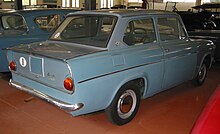
Anglia Super 123E (1962–67)
| Ford Anglia Super 123E | |
|---|---|
I4 |
From 1962, the 123E Anglia Super was available alongside the 105E, replacing the last of the line of Prefects, with a larger 1198 cc engine and other refinements.
The same car was also sold in continental Europe. One mainland Europe-only variant was the Anglia Sportsman, which carried its spare tyre on the back, somewhat similar to the
Anglia saloons were provided with various levels of trim. The base model was the Standard, and this sported no chromework, painted rear light surrounds, steel-slatted grille, and limited interior trim. The Deluxe had a chrome side strip, chrome rear lights, glovebox lid, sun visor, and full-width chrome radiator grille. The top of the range was the Super, which had twin chrome side strips, contrasting coloured roof and side flash, plusher interior trim, together with the 1198 cc engine and a gearbox with synchromesh on first gear.
Optional extras were the mechanical upgrade of a Deluxe to a Super, retaining the Deluxe trim, or the upgrade of a Deluxe to a Super trim, but retaining the 997 cc engine, an option rarely taken up.[citation needed]
-
Ford Anglia Sportsman (1965)
Scale models

- Meccano Dinky Toys; No. 155 (production 1961–1964), Anglia 105E deluxe with mostly red interior although a few have appeared with a blue interior, approximately O scale (1:43).[30]
- 00 scale.[32]
- Lledo Vanguard series; No. unknown (production unknown 1996 - date (later production under Corgi Vanguards 1/43), Anglia 105E, approximately O scale (1:43)
- VV model no.1622
- Numerous models of a circa 1960 Anglia as portrayed in the Harry Potter series exist. One is the Lego set 4 Privet Drive (#75968).
References
- ^ ISBN 1-870979-39-7.
- ^ a b c d e f g h Ballard, Bill (2003). English and Australian Small Fords: Recognition and Restoration. pp. 54–55.
- ^ a b c d e f g h i j k l Howard, Geoffrey (29 April 1971). "Design Progress: Small Fords". Autocar. 134. (nbr 3918): 9, 10–12.
- ^ Ballard, p. 48
- ^ a b c d e f g h i j k Ballard, p. 62
- ^ The Motor. 27 October 1948.
- ^ Ballard, p. 64
- ^ a b c d e f g h Ballard, pp. 70-71
- ^ Darwin, Norm (1986). The History of Ford in Australia. p. 101.
- ISBN 0-333-16689-2.
- ^ The Motor. 26 May 1954.
- ^ "Ford Anglia Saloon (road test)". Autocar. 2 October 1952.
- ^ "Ford 1957". Classic Car Catalogue. Retrieved 12 December 2014.
- ^ "British and European Car Spotters Guide - 1958". www.uniquecarsandparts.com.au. Retrieved 12 December 2014.
- ^ "New Anglia Here". Australian Motors Sports: 49. February 1960.
- ^ The Motor. 10 September 1959.
- ^ "1960 Ford (U.K.) Anglia 105E-123E Saloon performance data, specs & photo". Automobile-catalog.com. Retrieved 20 November 2011.
- ^ a b c d e f Mullins, John (March 1985). "Time Machines: Little belter: Ford Anglia 1959–1967". Drive (Magazine of the British Automobile Association). 116: 18–19.
- ^ "Cheap Wheels" (PDF). Collectible Automobile: 85. February 2000.
- ^ "Classic Ford Anglia 105E". Telegraph. 4 January 2011. Retrieved 20 November 2011.
- ^ "Dash Layouts | Ford Anglia 105E Owners' Club". Fordanglia105eownersclub.co.uk. Archived from the original on 15 November 2011. Retrieved 20 November 2011.
- ^ Francis, V. L. (Director) (1962). Milestones at Montlhéry (Film). Britain: Ford Motor Company Ltd. 1:00 minutes in.
Brainchild of 24-year-old twins Mike and Tony Brookes
- ^ "Ford Anglia 105E Guide, History and Timeline from". Classiccars.co.uk. Retrieved 22 August 2015.
- ^ a b Wright, Cedric, ed. (August 1968). "Owners mourn the end of the Anglia 105E era". CAR (South Africa). Vol. 12, no. 7. Cape Town, South Africa: Central News Agency Ltd. p. 37.
- ^ Owners mourn the end of the Anglia 105E era, p. 36
- ^ a b c d "Ford Anglia - Designations". www.anglia-models.co.uk. Retrieved 26 June 2015.
- ^ "Ford Anglia 307E Van - Brochures". anglia-models.co.uk. Retrieved 26 June 2015.
- ^ a b c "Ford Anglia 307E Van". anglia-models.co.uk. Retrieved 26 June 2015.
- ^ a b c d e f "Ford Anglia 105E Torino". www.anglia-models.co.uk. Retrieved 7 October 2013.
- ISBN 095093190X.
- ^ "Matchbox 7b Ford Anglia". toymart.com. Retrieved 26 June 2015.
- ISBN 095093190X.

